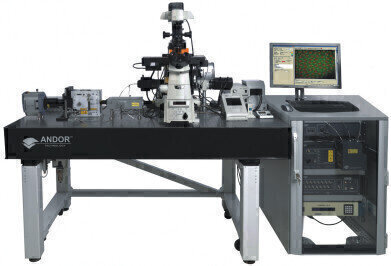Microscopy & Microtechniques
Cell Receptor Recycling Mechanism Discovery Opens up New Class of Therapeutic Targets
Jun 10 2011
Professor Manojkumar Puthenveedu of Carnegie Mellon University studies the mechanisms by which membrane trafficking controls and co-ordinates the complex signalling pathways in the brain. Despite the fact that almost all diseases can be traced to a defect in how cells respond to signals, little is known about how signalling pathways are maintained in normal cells and the changes that occur in abnormal conditions. Using the Andor Revolution XD Confocal Microscope for live cell studies, Professor Puthenveedu has led an international team of researchers to elucidate how signalling receptors are recycled to the cell membrane. The discovery of the mechanism by which signalling receptors travel back to the surface of the cell after activation and internalisation opens up a new class of therapeutic targets.
The team used live cell confocal fluorescence microscopy to label and image beta-2 adrenergic receptor (b2AR), the receptor for adrenaline and noradrenaline and one of a group of G protein-coupled receptors (GPCRs) pivotal to the regulation of heart and lung function, mood, cognition and memory, digestion, and the inflammatory response. After internalisation, they found that b2AR was recycled via unique domains on the endosome, which they termed Actin-Stabilized Sequence-dependent Recycling Tubule (ASSERT) domains. Rapid turnover of endosomal actin was confirmed by FRAP (fluorescence recovery after photobleaching). The ASSERT domains trap and slow down the release of receptors to provide a slower pathway compared to the faster bulk recycling pathway and could potentially be targeted by pharmaceutical agents to control diseases resulting from abnormal cell signalling. “Confocal fluorescence microscopy has been the driver for an explosion in the study of dynamic processes in living cells, but not all systems
are created equal. We have created an instrument that optimises sensitivity, acquisition speed and specimen viability,” said Mark Browne, Director of Systems at Andor. “The high optical efficiency of the Revolution XD spinning disk system allows the use of reduced laser power and, therefore, lowers the risk of phototoxicity to the specimen during long term experiments while Andor’s IQ software ensures precise synchronisation of illumination, detection and scanning for unparalleled image quality and acquisition rates.”
Digital Edition
Lab Asia 31.2 April 2024
April 2024
In This Edition Chromatography Articles - Approaches to troubleshooting an SPE method for the analysis of oligonucleotides (pt i) - High-precision liquid flow processes demand full fluidic c...
View all digital editions
Events
May 05 2024 Seville, Spain
InformEx Zone at CPhl North America
May 07 2024 Pennsylvania, PA, USA
May 14 2024 Oklahoma City, OK, USA
May 15 2024 Birmingham, UK
May 21 2024 Lagos, Nigeria







.jpg)










